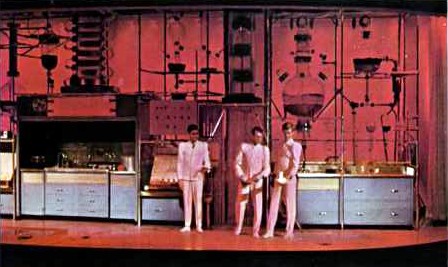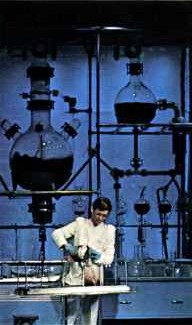Source: Book
"Science at the Fair"
| 02.
Rubber vs. Adiprene Balls in Freon. A
rubber ball frozen in Freon will shatter like glass when dropped
on the floor. A ball made of DuPont Adiprene, on the other hand,
retains its elasticity and bounces after its immersion in Freon. |
|
3. Disappearing Blue. In this demonstration a large flask containing
a clear liquid changes to a deep blue color when the flask is
shaken. This blue color slowly changes back into a clear solution
again. This can be done repeatedly by simply shaking the flask.
This demonstration is based on the fact that a certain indicating
dye will turn deep blue when combined with air which is accomplished
by the shaking. Another chemical in the flask reverses this situation
and the liquid becomes colorless. |
|
4. Hindu Rope Trick.
This demonstration
features DuPont Stren which is a Nylon fishing line. It is so
fine and transparent that we can reconstruct the well known Hindu
Rope Trick by attaching the Stren to a piece of manila rope and
using it to lift the rope, which then hovers in mid-air as though
unsupported. |
|
5. Conductive Paint. A tape recorder is separated from its loud-speaker
by a panel of transparent plastic sheet so that although the
tape recorder is mechanically operating, no sound comes out of
the loudspeaker since it is not electrically connected. An aerosol
dispenser containing a paint which conducts electricity is used
to "spray" 2 "wires" leading from the tape
recorder to the speaker. Completion of the second "wire"
electrically connects the speaker and it begins to play. |
|
6. Instant Nylon. A
large container contains 2 liquids, one of them floating on the
other. Where the two liquids meet, polymerization occurs and
pure nylon is produced. This film of nylon can be lifted out
of the liquids by wearing rubber gloves and reaching through
the top liquid. this process is continuous and a cord of nylon
can be drawn continuously from this container until one of the
liquids is depleted. |
|
7. Dacron 88. A
strand of unstretched Dacron 88 is held and stretched to over
twice its length. When the strand is released, the stretched
fiber bunches up or fluffs since each individual filament has
now become crimped by the stretching process. |
|
8. Baymal. A
tube about 3' long and 4" in diameter is partly filled with
a thick white liquid, Baymal. This substance is thixotropic;
i.e., the liquid gels or becomes firm in about 10 seconds so
that if the cylinder is held vertically with the liquid Baymal
at the bottom, in 10 seconds it can be turned over so that the
Baymal stays at the top. The Baymal can be liquefied by simply
shaking the tube after which it will gel again. This can be done
endlessly. |
|
9. Lucite Paint. Lucite
Paint is also thixotropic, which is the reason for its "no-drip"
qualities. To prove this, we drape an expensive fur or orlon
coat over a table using it as a drop cloth. The open can of paint
is placed on the coat and a panel held above the coat is painted. |
|
Showman's hand is shielded by "Tipersul"
fibrous potassium titanate when he holds 1800°F. coupling.
 |
10. Tipersul. A
performer lays a piece of 1/8" Tipersul on his open palm
and an assistant places a red hot bolt on the Tipersul. This
thin sheet protects his hand and the performer shows the high
temperature of the bolt by dropping it on a piece of wood which
catches fire.
|
| 11. Mylar and Butacite Drum. Two drums about 3' in diameter have their ends
covered with Mylar and Butacite respectively. A heavy solid Lucite
bowling ball is dropped onto the plastic sheets from a height
of about 3'. upon striking the Mylar, the ball rebounds sharply.
The Butacite drum, however, cushions the blow and the rebound
of the ball is substantially less. |
| 12. Jacob's Ladder. A
50,000-volt arc up to a foot long is generated between two vertical
rods in the form of a "V". A piece of wood placed in
the gap catches fire immediately because of the intensity of
the arc. A sheet of Mylar is then placed in the gap, power turned
on, but the arc does not strike due to the high insulating ability
of the Mylar. As soon as the Mylar sheet is removed, the arc
is immediately generated. |
| 13. Zepel. A piece of cloth is prepared with
the letters Z-E-P-E-L printed on it with Zepel which cannot be
seen. Stains of various sorts such as ink, tomato juice, salad
oil, etc., are poured on the cloth and stain it completely except
where the material has been treated with Zepel. The letters Z-E-P-E-L
then stand out since they are unstained. |
| 14. Iodine Clock. In this demonstration a small quantity
of clear liquid is added to a large flask containing another
clear liquid. In the order of 10 seconds the solution turns instantly
black. |
|
Dyes change liquid's color each time it's poured.
 |
15. Color Sequence. The black solution from the previous demonstration
is then poured into 4 beakers. The black solution becomes colorless,
then red, then wine colored and finally blue as it is transferred
from one beaker to the other.
|
| 16. Parabolic Mirrors.
Two highly polished
parabolic mirrors 5' in diameter are mounted to face each other.
A light source at the focal point of one mirror is used to reflect
light from that mirror through a distance of about 50' to the
other mirror. The second mirror refocuses the light at its focal
point at which a match can be ignited. |
| 17. Vortex Gun. A
Vortex Gun 4' in diameter generates a vortex (concentrated jet
of air) which is used to blow out a flame, rattle a sheet of
paper, etc. (at a distance of 40' to 60')/ |
| 18. Chemiluminescence. A small amount of liquid is added to about a quart
of liquid in a 6-qt. spherical flask. when the mixture is shaken,
intense blue or yellow is produced. This light is generated completely
by the chemicals in the flask. |